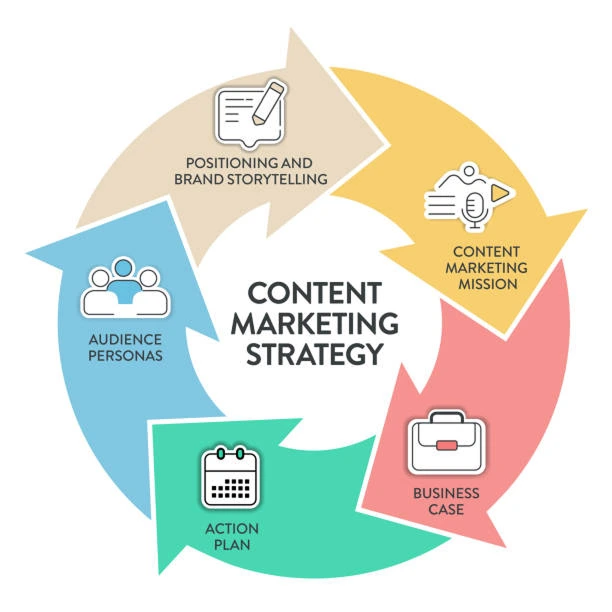
Why Blogging Still Works for Businesses
You’re on the correct track if you’re thinking about how to start a blog for your business. In 2025, blogging is still a great way for businesses to get more visitors, create trust, and turn leads into devoted consumers. Even while social media and video material are becoming more popular, blogs have some distinct benefits: they are always up-to-date, easy to find, and great for showing off your knowledge. A good blog may make your brand more visible, help your blog SEO, and give you credibility in your field. This article will show you how to start a blog from the ground up, including how to set goals, learn about blog SEO, and make a blog marketing strategy that works.
Let’s go into the actions you need to take to start a blog that will help your business develop.

Step 1 – Define Your Purpose and Target Audience
Before writing, know your blog’s purpose and audience. A blog that doesn’t have a clear purpose is like a ship without a compass; it won’t go where it’s going.
Understand Your Business Goals
What made you want to learn how to start a blog? Your goals affect everything, from what you write about to how you write it. Some common aims for business blogs are:
- Lead Generation: Get potential clients to notice your business by talking about their problems.
- Brand Awareness: Make your firm more visible and position it as an industry leader.
- Teach Your Customers: Provide them with useful information to gain their confidence and loyalty.
- SEO Boost: Get your website to show up higher in Google and other search engines.
A SaaS company might blog on the features of its products, while a local bakery might publish recipes to get people in the area interested. Set targets that can be measured, such as getting 50 new leads every month or boosting traffic to your website by 20% in six months.
Choose the Right Niche or Category
Your blog’s niche should align with your business and the readers. If your niche is too wide, like “lifestyle,” it can make it harder to stay focused. If it’s too tight, it can make it harder to come up with new content ideas. To identify the sweet spot, you need to:
- Figure out who your ideal consumers are. What issues do they have? Use things like Google Analytics or customer surveys to get information.
- Look into your competitors: Check out what other businesses like yours are writing about on their blogs. Find places where you can add your unique point of view.
- Use what you know: Talk about things that your firm does well. A financial counselor might write a blog post about planning for retirement, while a fitness company might write about workout routines.
For example, a digital marketing agency might focus on “small business growth strategies” to get the attention of business owners. Focusing on one thing makes you stand out and enhances your blog SEO.

Step 2 – Choose the Best Blog Platform and Set Up Your Blog
Picking the right platform and setting up your blog the right way are the first steps to success. Let’s take it apart.
Compare the Best Blog Platforms
The best blog platform for you will depend on how much money you have, how good you are with technology, and what you want to do with your site. Here’s a brief look at some of the most popular choices:
- WordPress.org: Very flexible, ideal for enterprises that want to be in charge of everything. Needs hosting and some technological knowledge. Good for SEO blogs and growth.
- Wix: Easy to use and lets you design by dragging and dropping. Great for novices, but not as adaptable for advanced modification.
- Squarespace: Has sleek layouts for blogs that look appealing. Great for tiny enterprises that care more about looks than complicated features.
- Medium: Free and easy to use, but you can’t choose how you brand or make money. Best for personal blogs and more business-focused blogs.
- Ghost: A simple and quick tool made for those who make content. It is good for SEO, but you need to host it yourself.
WordPress.org is the best choice for most businesses because it is flexible, excellent for SEO, and has a huge library of plugins. For the best speed, use it with a trustworthy host like Bluehost or SiteGround.
How to Start a Blog (Technical Setup Basics)
This is a simple tutorial on how to start a blog on WordPress.org:
- Buy a domain name and hosting. Choose a domain name that goes well with your brand, such as yourbusiness.com. Pick a web host, such as Bluehost or SiteGround.
- Install WordPress: Most hosts allow you to accomplish this task with just one click.
- Choose a Theme: Pick a professional-looking theme that looks nice on mobile devices, like Astra or GeneratePress. It should match the colors and emblem of your brand.
- Add Important Plugins: For blog SEO, use Yoast SEO; for speed, use WP Rocket; and for spam protection, use Akismet.
- Make Basic Pages: Make a page about yourself, a page where people may contact you, and a page for your blog to indicate that you are trustworthy.
Must-Have Features for a Business Blog
These items will help your blog get more visitors and improve it for them:
- Mobile Responsiveness: More than half of all web traffic originates from mobile devices. Make sure your theme works on every device.
- SEO: Use plugins like Yoast or Rank Math to make your sitemaps and meta tags better.
- Fast Loading Speed: Use a caching plugin to make photographs smaller so they load in less than two seconds.
- Simple to Use: Include a menu with “Blog,” “Services,” and “About” links.
- Forms to Get Leads: Add opt-in forms to your site with Mailchimp or ConvertKit so you can collect email addresses.
Users and search engines can easily use a blog that is well organized.

Step 3 – Build a Blog Content Strategy That Works
The content is what makes your blog stand out. A structured approach makes sure that your postings are beneficial for your business and connect with viewers.
Define Your Content Pillars
“Content pillars” are the primary ideas that your blog will cover. These rely on your niche and what your audience desires. For example, a marketing agency’s pillars might be:
- SEO and marketing through content
- Ideas for social media
- Tips for email marketing
Each pillar should be in line with the challenges your audience has and the goals of your business. Make a list of 5 to 10 primary topics, and then make a list of subtopics for each one. This keeps your writing on topic and intriguing.
How to Create a Content Calendar for Your Blog
A content calendar helps you remain on track and keep your blog neat. Here’s how to create a content calendar for your blog:
- Pick a time to post: To keep up with quality and regularity, try to update once or twice a week.
- Plan themes: List the issues related to your pillars that you want to discuss in the next 3–6 months. Include themes that are popular or that come up at different times of the year, such as “Holiday Marketing Tips.”
- Use tools like Trello, Asana, or Google Sheets to help you plan posts, assign tasks, and keep track of deadlines.
- Change things up a bit: Write in different ways, such as how-to guides, listicles, and case studies, to keep readers interested.
A fitness website might include “Best Home Workouts” on its calendar in January (for New Year’s resolutions) and “Summer Fitness Tips” in June.
Blog Post Examples and Inspiration
Are you seeking some ideas? Here are blog post examples about a range of subjects:
- Online shopping: “10 Things You Need for [Season]” or “How to Choose the Best Gift.”
- SaaS: “The 5 Best Things About [Product]” or “How Our Tool Saves You 10 Hours a Week.”
- Local company ads could say things like “Why [City] Loves Our [Service]” or “A Day in the Life at [Business].”
Look at your competitors’ blogs or use tools like BuzzSumo to find out what other people in your field are talking about.

Step 4 – Learn Blog SEO Fundamentals
A blog needs SEO to do well. It gets real people to come to your site and makes sure that the right people see what you write.
On-Page SEO for Blog Posts
On-page SEO makes search engines find all of your content quickly. Key elements include:
- Title Tags: Your title should be less than 60 characters long and have your goal phrase, such as “how to start a blog.”
- Meta Descriptions: Include keywords in short, intriguing summaries (150–160 characters).
- Headings: Use H1 for the title and H2 and H3 for the subheadings. Put in keywords that have something to do with the title, such as “blog SEO tips for businesses.”
- Structure of URLs: Your URLs should be short and include a lot of keywords. For instance, your URL could be something like yoursite.com/how-to-start-a-blog.
- Name the pictures and give them alt text that tells what they are, such as “business-blogging-strategy.jpg.”
Keyword Research and Optimization
Keyword research tells you what words individuals in your target market are searching for. You can use Ahrefs, SEMrush, or Google Keyword Planner to find keywords that get a lot of traffic yet aren’t too difficult to rank for. Focus on:
- Primary Keywords: These are terms or phrases like “how to start a blog” or “blog marketing strategy.”
- Long-Tail Keywords: These are very precise words, such as “how to create a content calendar for your blog.”
- Search Intent: Make sure that users can find what they want in your material. For instance, make sure there are “how-to” guides that you can read.
Don’t use too many keywords in the titles, headings, or body of your article. Instead, use them in a way that feels right.
Blog SEO Tips for Businesses
Here are some helpful blog SEO tips for businesses:
- Improve your local SEO: If you own a business in a given location, use keywords that are connected to that area, like “tips for bakeries in Chicago.”
- Update Old Content: To keep your rankings, add new keywords or content to stuff that is currently there.
- Use Schema Markup: You can use plugins like Yoast to add structured data to your website. This will help search engines find your site more easily.
- Make the User Experience the Most Important Thing: Google gives sites with low bounce rates and high engagement higher ranks.
SEO takes time, but if you do it every day, your rankings will go higher.

Step 5 – Write Posts That Educate and Convert
A good blog post should teach people something and get them to do something, like buy your product or join up for a newsletter.
How to Write a Blog Post (Structure + CTA)
This is a tried-and-true technique for how to start a blog:
- A headline that catches the eye: Use statistics, questions, or rewards to persuade visitors to read your article, such as “10 Blogging Mistakes to Avoid.”
- An introduction that grabs your attention: To keep readers interested in the first 100 words, start with a problem, a statistic, or a story.
- Body Content: Use bullet points, subheadings, and short paragraphs to make it easy to read.
- Here are some tips that you can implement right away: Provide readers with actionable steps they can take immediately to assist them.
- Strong CTA: Finish with a strong call to action, such as “Get in touch with us for a free blogging checklist” or “Contact us for a consultation.”
Put calls to action (CTAs) in the content, like “Sign up for our newsletter to get more tips on how to start a blog.”
Using Blog Content to Get Clients
Blogs are a terrific way for others to get in touch with you. To use blogs to get clients:
- Talk about issues: Write articles that help readers with specific problems, such as “How to Get More Traffic to Your Website.”
- Demonstrate your skills: Use real-life examples or stories of success to illustrate that you know what you’re talking about.
- Give away gated content: In exchange for email addresses, give away free digital items like eBooks and templates.
- Add CTAs that lead to service websites, consultation forms, or demos of your products.
A consulting company might produce an article called “5 Mistakes Businesses Make with Budgeting” and then offer a free consultation to urge them to act.
Evergreen vs Trending Content
- Evergreen Content: Common topics like “how to start a blog” and “blog SEO basics.” These always draw in visitors.
- Trending Content: Things that are happening right now, like “New Google Algorithm Updates” or “2025 Marketing Trends.” Initially, trending content attracts a lot of traffic, but this surge may not be sustained over time.
You need to establish a balance between the two to be successful in the long run. Evergreen content is useful for a long time, yet trending posts are based on what’s popular right now.

Step 6 – Promote Your Blog and Drive Traffic
You can’t only write great content; you also have to promote it so that people can find it.
Social Media, Email & Repurposing
- Social Media: Share on sites like X, LinkedIn, or Instagram. Check to see if the content works on all platforms. For instance, make short videos for Instagram and long threads for X.
- Email Marketing: Send a short teaser and a link to your email list for new posts. This is easy using Mailchimp and other tools.
- Reusing: Turn your blog posts into infographics, videos, or podcasts to attract more people to read them. For example, you could make a YouTube movie out of an article about “how to start a blog.”
Blog Marketing Strategy That Grows Authority
If you use the right blog marketing strategy, your brand will look more trustworthy:
- Guest Blogging: Write for well-known blogs in your field. It helps you attract more people to read your work and links back to your site.
- Work Together: Do interviews or write blog posts with people or businesses that have many followers.
- To join your community, talk to your blog followers and reply to their comments.
These recommendations will make your blog a useful place to go.
Internal Linking & Blog Architecture
Internal links are good for SEO and keep users on your site. For example:
- Link posts that are related to each other, like “how to start a blog” and “blog SEO tips.”
- Create pillar pages that link to related topics. For example, a “Blogging Guide” may connect to entries about SEO, how to start a blog, and how to create a content calendar.
- Use anchor language that makes sense instead of “click here,” like “learn how to start a blog.”
Tags and categories will make it easier for people to find what they want on your site.

Step 7 – Measure, Improve, and Build Authority Over Time
Blogging is more like a long race than a short one. Review your progress and adjust your plan to maximize its effectiveness.
How to Build Blog Authority
To make your blog more reliable, you should:
- Post useful, well-researched information regularly.
- Links Back: To get links from well-known sites, either write guest posts or get in touch with them.
- E-A-T stands for experience, expertise, authority, and trustworthiness. These are the most important things to Google. Show off your skills and present trustworthy sources.
- Engagement: To show search engines that you are an expert, urge people to remark, share, and interact with you.
Key Metrics to Track Performance
Google Analytics and Google Search Console can help you keep an eye on things:
- Organic Traffic: Find out how many people use search engines to find your site.
- Bounce Rate: If it’s less than 60%, the content is interesting.
- Conversion Rate: Keep an eye on things like purchases or form submissions.
- Keyword Rankings: See how well your material does for phrases like “SEO blog” and “how to start a blog.”
Check your stats every month and introduce changes to your plan if you need to. You can tell more people about an article or add more keywords to it if it isn’t getting many views.
Your Business Blog is an Asset, Not a Chore
A blog for your business can help it grow. You’ll have a powerful tool that brings in traffic, builds authority, and turns visitors into sales if you know what you want to do, choose the best blog platform, plan how to market your blog, and learn how to do blog SEO. To get results, do the following things in this guide: Plan your content, improve it, and market it well to the right individuals. When you blog, you do more than just write. You also talk to your readers and get the word out about your brand. And your blog will play a giant role in your brand’s future success. Here are some key steps to guide you:
How to start a blog takes advantage of flexible tools like WordPress.
How to start a blog kicks off with clear, actionable goals.
How to start a blog involves picking a platform tailored to you.
How to start a blog means mastering blog SEO to boost traffic.
How to start a blog relies on a solid marketing plan for success.
How to start a blog requires steady effort to grow authority.
How to start a blog shines with regular updates to stay fresh.
How to start a blog thrives on engaging your audience regularly.
How to start a blog leverages tools like WordPress for flexibility.
How to start a blog grows through strategic content planning.
How to start a blog starts with understanding your audience’s needs.
How to start a blog relies on consistent posting to maintain momentum.
How to start a blog enhances visibility with effective promotion.
How to start a blog requires learning from analytics for improvement.
How to start a blog grows stronger with regular performance reviews.
How to start a blog benefits from collaborating with industry peers.



